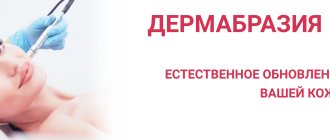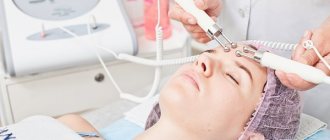Movements are carried out smoothly to prevent impact on the thyroid gland. The intensity of the action gradually increases, and the frequency of electrical impulses decreases to zero.
In order to normalize the acidity of the epidermis, the skin is re-exposed, but with a positively charged electrode.
During the procedure, a chemical reaction occurs, as a result of which soap foam forms on the face. It is easily washed off with water. At the end of the procedure, the face is cleansed of any remaining liquid, covered with a mask with nourishing ingredients, and moisturized with cream. The session lasts about 30 minutes.
What to do after the procedure
After thoroughly cleansing your face, you should refrain from wearing makeup or using cosmetics for 12 hours. The skin has become more sensitive than it was before.
It is important to protect it from aggressive influences: UV radiation, mechanical pressure, chemical and temperature factors. Even water can have a negative effect on the skin.
To avoid irritating your facial skin, you should avoid the following for 2-3 days:
- Solarium;
- Taking water procedures;
- Beach visits.
To restore the epidermis, it is recommended to use nourishing masks, moisturizers, and cosmetic clay.
How is the disincrustation procedure carried out?
The current used for the disincrustation procedure is called galvanic, which means a constant electric current of low voltage and low strength. Its name comes from the name of the Italian scientist, the founder of experimental electrophysiology, Luigi Galvani, who lived in the 18th century. Later, in the 19th century, the German scientist Johann Schweigger invented a galvanometer device, which became the predecessor of modern devices used for disincrustation.
The basic package of galvanic devices used for cleaning includes a unit that rectifies and equalizes alternating current from city networks, combined with a control panel, and two electrode handsets.
The first electrode in the form of a metal rod is connected to the connector with the “+” sign and placed in the client’s hand. In some devices, this function is performed by a plate placed on the body near the procedure area (forearm, back). The second electrode, usually a metal roller or roller, is connected to the connector with the “-” sign; this is the main working handpiece. Nevertheless, there are often electrodes in which two electrodes (“+” and “-”) are working, that is, they work simultaneously.
Galvanic cleaning is carried out using an alkaline disinfectant solution. These can be either special preparations or an aqueous solution of alkaline compounds, for example: 1–2% sodium bicarbonate solution, 2% sodium salicylate solution, 5% sodium carbonate solution and others. The procedure is also carried out using a hydrophilic pad. This can be a napkin that is soaked in disinfectant and applied to the client’s skin, a spongy cloth, a cotton pad, or a special pad that is used to wrap the electrode roller, which is dipped into the solution.
Body tissues consist of charged particles (ions) and are electrically conductive, so the procedure is based on the ability of galvanic current to attract ions. Current enters the body through the ducts of the sebaceous and sweat glands and intercellular gaps.
The negative electrode attracts positive ions, and as a result of hydrolysis, alkalis are formed, including sodium hydroxide, which reacts with fatty acids and saponification occurs. Saponification products dissolve in water and are easily removed from the pores and skin surface.
The procedure is performed on the face with an emphasis on the T-zone (forehead, nose, chin), as well as in the décolleté and back.
Indications for the use of desincrustation are: oily and combination skin, multiple comedones, liquid and dry seborrhea, non-inflammatory acne, post-acne, some types of pigmentation.
Under the influence of galvanic current, blood vessels dilate, blood flow accelerates, vascular permeability and the intensity of cellular metabolism increase, and cell hydration occurs.
Efficiency – before and after the procedure
In addition to deep cleansing of pores, galvanic facial cleansing is a technique for smoothing out fine wrinkles, giving the skin firmness and elasticity, and improving the functioning of the sebaceous glands. Galvanotherapy helps eliminate blackheads and refresh the complexion. Improvements are visible after the first session, but it is impossible to completely eliminate skin imperfections at one time. To achieve maximum effect, it is recommended to complete a full course of disincrustation.
There are examples when the galvanotherapy procedure does not lead to positive results. After several sessions, the skin still remains oily and dirty. The number of blackheads on the face increases compared to what it was before the procedure. The problem may be caused by improper functioning of the thyroid gland, so in this case you should seek help from an endocrinologist.
When the procedure is carried out by an inexperienced doctor, violating its technique, the “after” result can cause a terrifying effect. Without following safety rules, there is a risk of skin burns, capillary damage, and bruising.
Electroplating in hardware cosmetology.
Let's give an electric shock to blackheads: galvanic facial cleansing.
You can look at cosmetology devices with galvanization function on the Multifunctional facial skin care machines page by following this link.
Caring for problem skin has always been and remains one of the most popular procedures in the work of cosmetologists. Oily skin, strewn with blackheads and prone to inflammation, not only has an unaesthetic appearance, but also threatens its owner with the development of acne, which is often very difficult to fight.
Oily skin is more likely to develop blackheads (acne). This is due to increased sebum secretion and insufficient exfoliating ability of the horny epidermis. Acne can be open (blackheads) or closed, deep. The blackhead has a communication with the external environment, so its tip is oxidized by oxygen and you can see a black dot on the skin. If the acne is not removed in a timely manner, then a bacterial infection can easily join the sebum accumulated in it, and then a more complex skin element with a suppurative process develops, as a result of which deep scars often form on the skin.
The most effective method of removing acne has always been mechanical (manual) cleaning. But it has its own list of contraindications and is quite painful. Therefore, hardware cosmetology comes to the rescue in working with clients who have a low pain threshold and contraindications to mechanical cleaning. One of the methods of hardware cosmetology is disincrustation - cleansing the skin using galvanic current.
The principle of the disincrustation method using a galvanizing apparatus.
The positive effects of electric current on the skin have been known for a long time. Low-frequency current has a beneficial effect on blood circulation and cells of the epidermis and dermis, regulating their work. Under the influence of galvanization, sebum easily reacts with alkaline solutions to form soap. For the procedure, the contact medium is a special disinfectant tonic, which includes baking soda.
Under the influence of current, the following occurs: - loosening of the dead layer of the epidermis; - opening of pores; - liquefaction and saponification of comedones; ― positive effect on the sebaceous glands; - improvement of blood circulation; - increasing skin tone.
The work of cleansing the skin is carried out with a negative electrode, after which the cosmetologist changes the polarity and completes the cleansing with a positive electrode, the action of which helps close the pores and introduce the active components of the serum on which the doctor works. Thus, depending on the polarity of the electrode, galvanization can both cleanse the skin and serve as a tool for administering drugs through an electrical impulse. This method is quite capable of introducing vitamins, microelements and hyaluronic acid into the basement membrane.
Indications for disincrustation: 1. Oily and combination skin. 2. Thick and liquid seborrhea. 3. Sensitive skin. 4. Spider veins, nearby vessels. 5. A large number of blackheads. 5. Increased sensitivity to pain and the presence of contraindications to manual cleaning. 6. Pigmentation and photoaging. 7. Small wrinkles. 8. Decreased tone and sagging skin. 9. Uneven complexion.
Galvanic cleaning procedure
1. Cleansing the skin of makeup and impurities (using gels for washing). 2. Toning (tonic according to skin type). 3. Application of a disinfectant solution. In some cases, the solution can be applied not to the skin, but to a special gauze cloth that is wrapped around the electrode. 4. The positive electrode is attached to the client's right forearm. This is done to ensure that the electrical circuit does not pass through the heart area. A negative electrode is used to work on the client's face. More contaminated areas are treated especially carefully. 5. Repeated washing to remove fat saponification products. 6. Applying an anti-inflammatory moisturizing concentrate to the skin. 7. Work with a positive electrode concentrate to nourish the skin and close pores. 8. Applying a mask according to your skin type. (After the concentrate, the mask is not a mandatory stage of care and you can do without it). 9. Completion of the procedure with toning and application of protective cream.
In the process of working on the face with galvanic currents, no unpleasant sensations usually arise; some may feel a metallic taste in the mouth. The duration of such cleaning, as a rule, is no more than 20 minutes.
After galvanic cleaning, the client feels fresh and has a slight lifting effect. If the skin is heavily soiled, one procedure is usually not enough, so you may need from 7 to 10 galvanic cleanses, which are usually carried out every one to two days. In some cases, several such courses of skin cleansing and treatment may be needed; all these issues are decided individually.
Contraindications to galvanic cleaning: 1. Increased sensitivity to electric current. 2. The presence of reinforcing threads. 3. Pacemaker. 4. Hypertension. 5. Heart disease. 6. Oncological processes. 7. Skin diseases (vitiligo, molluscum contagiosum). 8. Pregnancy. 9. Acute respiratory diseases. 10. Increased body temperature.
Galvanic facial cleansing is a modern method in cosmetology. Its advantages are not only that it is an effective and atraumatic way to cleanse the face of comedones and regulate the functioning of the sebaceous glands, but also that the effect of electrical impulses and nutritional concentrates on the skin is also an excellent prevention and correction of age-related changes.
Hardware cosmetology, method of galvanic facial cleansing, disincrustation, acne treatment, acne removal, apparatus for galvanization, galvanization apparatus, protocol for the galvanization procedure, galvanization, disincrustation using a galvanic apparatus, buy a galvanizing apparatus, buy cosmetology equipment, how to carry out the galvanizing procedure, apparatus cosmetology, how to get rid of acne, how to do electroplating, facial cleansing using a galvanizing apparatus. How to properly galvanize facial skin and where to buy a galvanizing machine
Compatible with other cosmetic procedures
Many people are interested in the question not only of what galvanic facial cleansing is, but also how it interacts with other methods of skin cleansing.
According to cosmetologists, to achieve maximum results, disincrustation can be combined with the following procedures:
- Manual facial cleansing;
- Vacuum cleaning of pores;
- Mechanical, laser peeling;
- Ultrasonic cleaning.
It is strictly forbidden to carry out galvanotherapy together with chemical peeling. When the procedures interact, there is a high load on the skin, which can cause injuries and serious consequences.
Side effects of using a galvanic facial machine
To date, no studies have been conducted to evaluate the side effects of galvanic facial treatments. However, galvanic current is widely used to treat facial palsy and Bell's palsy, so it is considered a safe treatment. However, one study evaluating the effects of electrical stimulation on human skin mentions that several participants experienced an “unpleasant feeling.” Some of them also felt slight pain.
Again, the level of sensitivity to stimuli differs from person to person. Some may have a high tolerance to pain, while others may be extremely sensitive to even mild irritants. This means that everything depends on you and the state of your body.
If you have metal dental fillings, crowns, or metal braces, be careful. People with these dental appliances may experience a metallic taste in their mouth during the procedure. Having metal in your mouth can even give you a galvanic shock, which can cause a mild headache or tingling sensation. But, with some precautions, you can go for this procedure.
Getting a galvanic facial at a spa can be expensive, but you can experience this luxury RIGHT AT HOME.
Can I do it at home?
Seeking independence from beauty salons and not wanting to spend extra money on procedures, many perform facial cleansing on their own.
Home galvanic therapy is no different from salon therapy, and also includes all stages: from preliminary cleansing of the skin to massage manipulations.
The only thing that is required for this is to buy a device for galvanic facial cleansing and thoroughly study the methodology for performing the procedure. If you are not confident that you can handle the task, then you should not take the risk. Even small mistakes in the deincrustation process can cause serious harm to your skin.
What is a galvanic facial machine?
Beauticians call this procedure a “non-surgical facelift,” which gives you youthful skin without having to undergo any surgical procedures or stick needles into it. It involves using a low level of current to infuse medications into the skin. In other words, galvanic facials use moderate-intensity direct current to stimulate skin cells, soften the skin, and deliver medications or creams deep into the layers of the skin. This is done to improve the hydration level and blood circulation of your face, thereby making it more radiant. And don't worry! It's completely painless - you won't even feel anything.
Typically, cosmetologists offer two types of galvanic facial treatments:
- Iontophoresis: During this procedure, a positively charged gel is applied to the skin. A negative electrode is then placed near your shoulder or asked to hold. A positively charged current now passes through the skin, which helps push the active ingredients applied to the skin deep into the epidermal layers. This dramatically increases the effectiveness of any skin products you use after undergoing this procedure.
- Desincrustation: This process uses galvanic current to soften and emulsify the keratin and sebum contained in your hair follicles. This is a way to prepare your skin for safe and painless comedones removal. Manual extraction follows this procedure. This is designed to deeply cleanse your skin and soften it at the same time.
Galvanic facial treatment is suitable for all skin types (including sensitive skin). This specialized leather treatment has many benefits.
Facial disincrustation has the following advantages
Alkaline reaction Softens tissue Expands follicles Increases blood circulation in lymph Increases sensitivity Softens sebum and keratin seals inside follicles Restores balance of sebum secretion
Disincrustation has gained great popularity and constantly receives good reviews due to its high efficiency.
The effect of the procedure is visible after the first session. If the procedure is carried out by a professional cosmetologist, the result will not take long to arrive.
Indications for disincrustation
- If the depth of comedones is insignificant, disincrustation completely replaces mechanical cleaning. The procedure is repeated three times in a row, daily.
- For deep comedones, disincrustation can significantly facilitate mechanical cleaning. In this case, the first two stages of the procedure are carried out (working with the negative pole and removing electrolysis products), followed by steaming and mechanical cleaning.
- After mechanical cleaning, you can perform preventive disincrustation procedures (once every 10-20 days), which allows you to delay the next mechanical cleaning or do without it altogether.
Substances used for galvanic cleaning can be in the form of an aqueous solution or in the form of a gel. Disincrustation gels can be applied to the skin and worked with a bare electrode. It is more convenient to pour aqueous solutions into a small container and moisten the electrode wrapped in a napkin in it.











